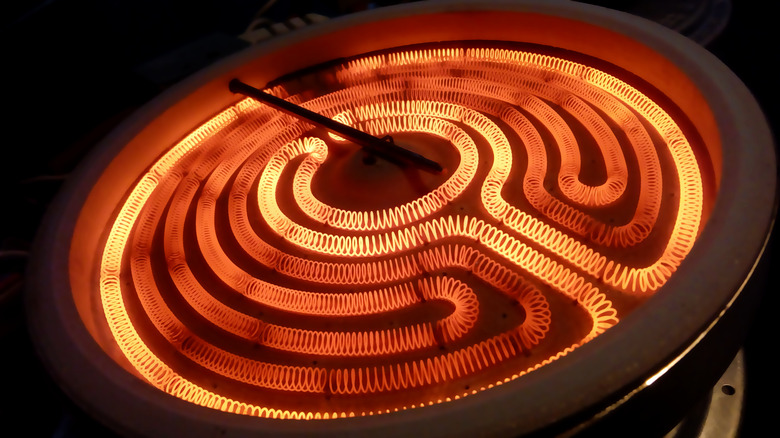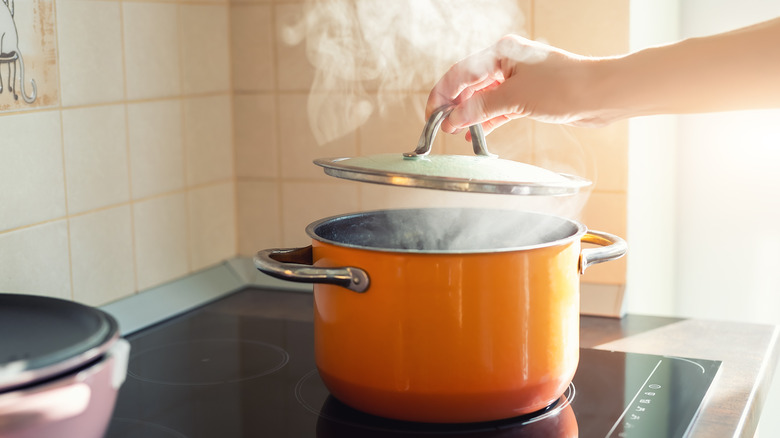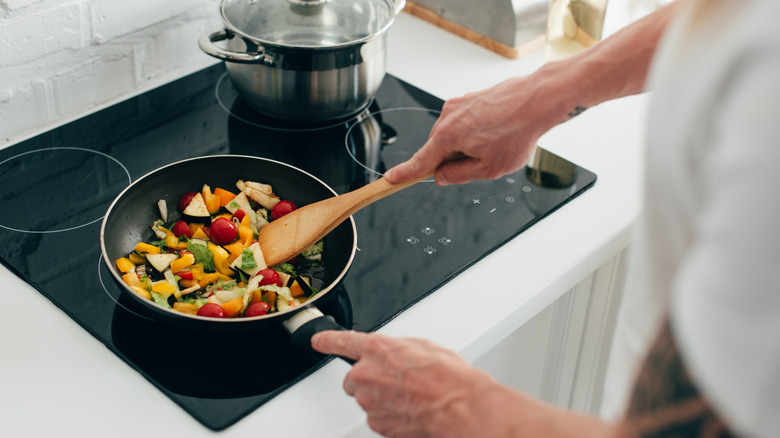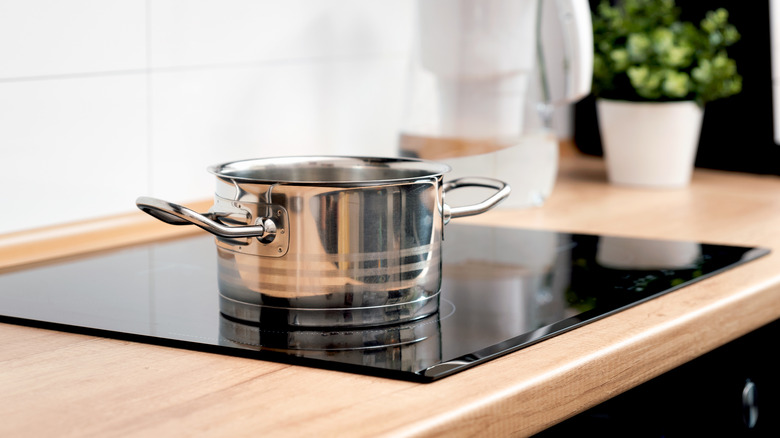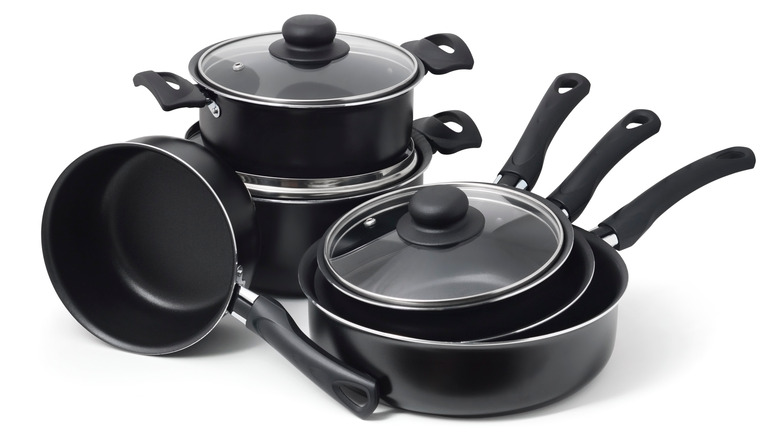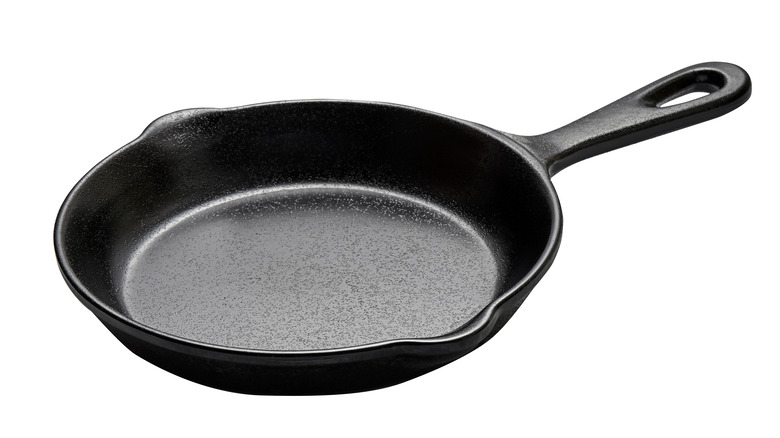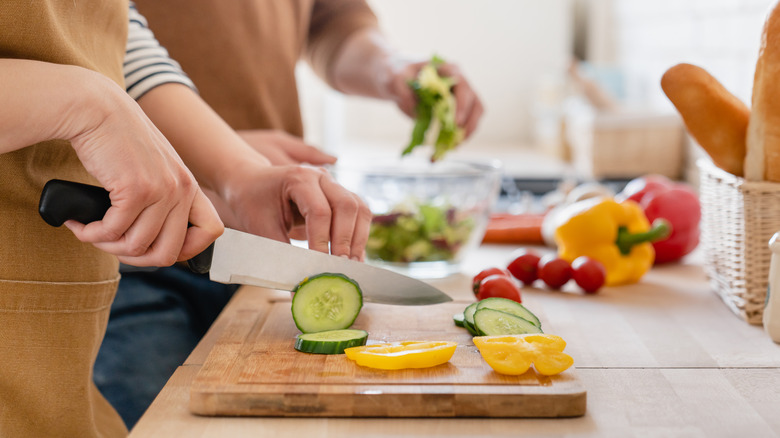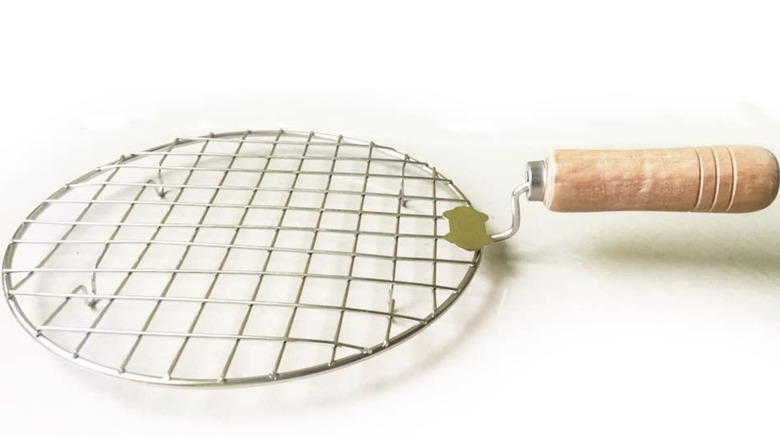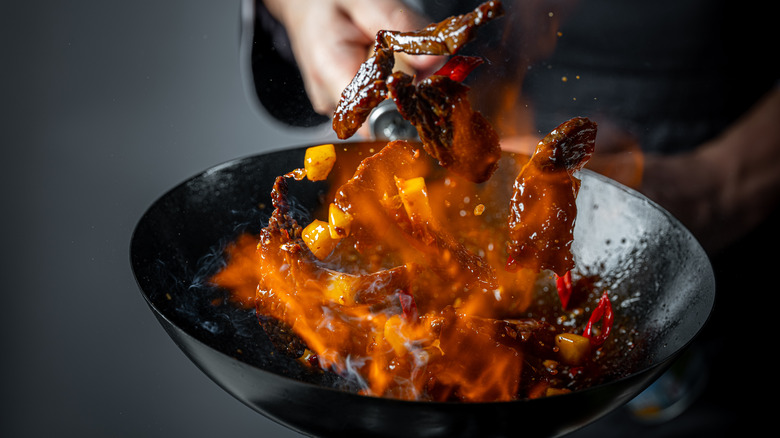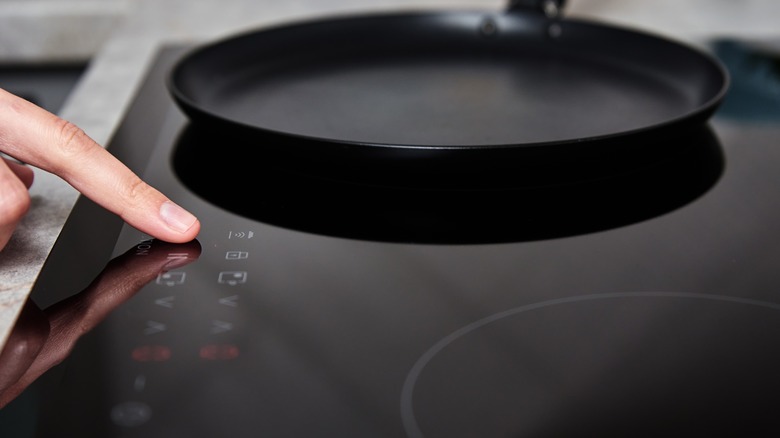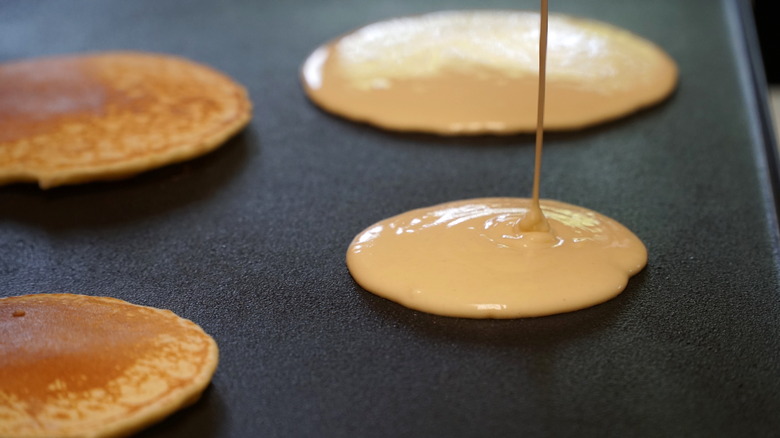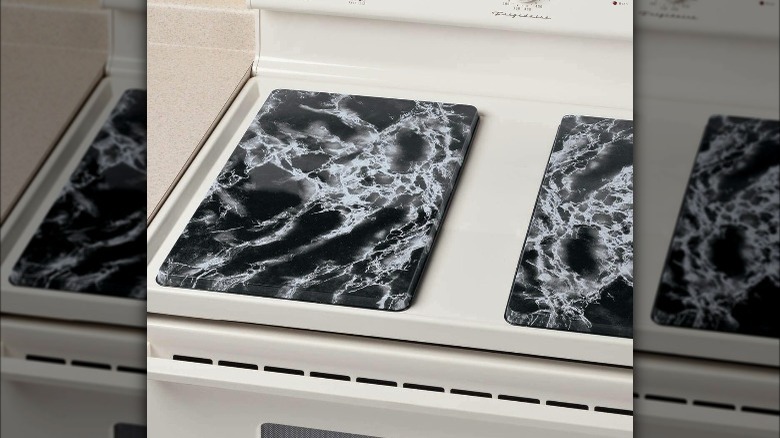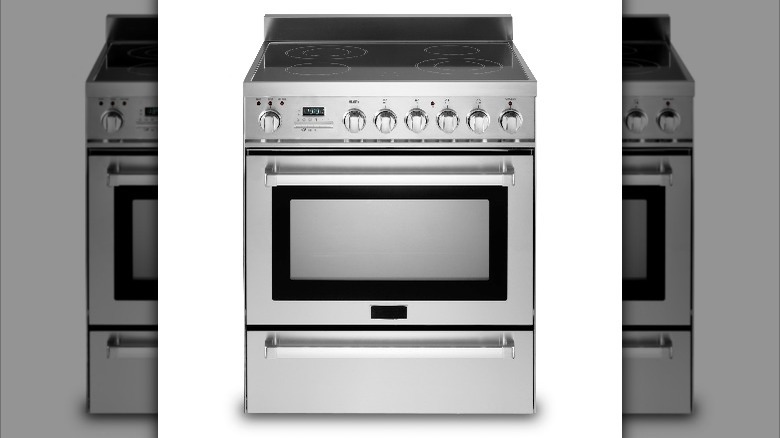Tips You Need When Cooking With An Electric Stove
People love to complain about electric stoves. Threads on Reddit and Food52 are full of posters kvetching about the perceived inadequacies of electric ranges. But are electric cooktops really all that bad? According to Consumer Reports, high-quality electric stoves outperformed their gas counterparts for both high-heat and low-heat applications in the publication's tests.
In addition to performance concerns, electric stoves might also be better for your health. Vox reports that gas ranges are bad for indoor air quality, as they produce undesirable chemicals like nitrogen oxide, formaldehyde, and carbon monoxide. They're not just bad for the air inside your home, either; per MarketWatch, gas stoves also may be contributing to climate change with the greenhouse gas emissions they produce.
We know that electric stoves aren't actually as bad for cooking as their reputation suggests, and that they're better for the planet, but that doesn't mean they don't have their quirks. Especially if you're used to cooking with gas, an electric stove is a big adjustment. That's why we've compiled these tips for cooking on an electric stove to make your life easier.
Move the pan on and off the burner to manage heat
One of the main differences between electric and gas stoves is how quickly they change temperature. With a gas stove, if you notice something is about to boil over or burn and you turn the stove down accordingly, the change happens quite fast. The flame instantly goes down, and since there's some airspace between the bottom of your pot and the heat source, extra residual heat leaks away swiftly (via Cook's Illustrated).
On an electric stove, if you turn the heat down, nothing happens at first. The coils (or glass surface, depending on what kind of stove you're using) stay hot for a while even after you turn the burner down. This issue is exacerbated by the fact that the extra heat has nowhere to go but into your pan, as your pan is actually touching the burner.
To avoid scorched eggs or a stovetop covered in over-boiled rice water, use the two-burner method. Either keep a second burner preheated to a lower temperature, or just move your pan to a burner that's turned off while you wait for the hot burner to cool down. This way, you can replicate the near-instant heat loss a gas stove provides.
Heat naturally turns on and off throughout the cooking process
Another quirk of electric stoves is that they don't stay on the whole time you're using them. Instead, the heating element regularly turns on and off in order to regulate temperature, according to stove manufacturers LG and GE. You might notice this phenomenon more at lower temperature settings, but even when the knob is turned all the way up, the burner will shut off occasionally to guard against excessive heat.
From a cooking perspective, this means you need to monitor the temperature of an electric stove closely. Just because it's the temperature you want right now doesn't mean it will be in a minute or two. It's not a big deal most of the time, but if you're cooking a particularly finicky recipe, it's something to be mindful of. One commenter on a Reddit thread about cooking on electric stoves mentioned that "having a vessel that can store tons of heat and dish it out compensates well for the deficiencies in an electric stovetop," so you might want to invest in heavy cookware to help regulate your cooking temperature.
Pay attention to the hot surface indicator
It's easy to tell when a gas stove has been turned off; it no longer produces a flame. With electric stoves, it's a little less obvious. The heating element will glow sometimes, but it still might be turned on even if it's not glowing. Furthermore, an electric burner can be plenty hot enough to burn you even if it's been turned off for several minutes. You don't want to leave a burner on accidentally, and you definitely don't want to burn yourself on a hot stove.
For those reasons, the hot surface indicator light is your friend. Both LG and GE say that the indicator lights on their stoves will remain lit until the burner drops below about 150 degrees Fahrenheit. That should be cool enough that it won't burn you badly from just a quick touch. Also, if you notice that the hot surface indicator light is on for a long time after you've stopped cooking, that's a sign that you probably forgot to turn the burner off all the way.
Use pans with flat bottoms
It's never great to cook with pans that have warped or dented bottoms, but having a nice flat cooking surface is particularly important when you're using an electric range. One person on a Food52 forum noted that when they used pots with crooked bottoms on their electric range stove, the pots shook while boiling water.
The advice to seek out flat-bottomed pans is confirmed by a company that makes electric stoves as well. GE says that if your pan doesn't make good contact with the burner, the heating element will turn on and off excessively. The company adds that it's particularly crucial to use high-quality flat pans on glass cooktops, as warped pots will not conduct heat well and could even damage your stove. Proper heat conduction is crucial for getting the results you want in the kitchen. If you have a set of cheap, thin, warped pans, they could be negatively affecting your cooking ability on an electric stove.
If you have a glass-top electric stove, choose your pans wisely
Glass and ceramic electric stoves definitely have some advantages over the old-school ones with exposed coils. For one, they look a lot snazzier, and they don't have nooks and crannies that food can fall into. They can also be used as an extension of your counter space, which is especially nice if you have a small kitchen (via SFGate).
However, while smooth-top stoves may look easy to clean, they damage very easily. It's best to use only approved cleaning products on them to avoid hurting the delicate glass surface. They can also be damaged if you use the wrong pan to cook on them.
According to GE, stainless steel is the most worry-free choice. You can use aluminum or copper, but they leave marks that need to be cleaned right after you're done cooking, or else they become permanent. Cast iron, with its rough surface, can leave permanent scratches. Perhaps the scariest option is porcelain/enamel-coated cookware, which could potentially attach itself to your stove's surface if it becomes too hot.
Get your prep done while your pan preheats
Electric stoves have a reputation for taking a long time to heat up compared to their gas counterparts, if this Reddit thread is to be believed. However, that depends on your specific model of electric stove. Consumer Reports tested a bunch of gas and electric stoves and found that many of the electric ones were hotter than even the hottest gas ranges.
If you don't have one of these nice electric stove models and find yourself frustrated by how long it takes to preheat your pan, you can use the extra time as an opportunity. One commenter on that same Reddit thread noted that they use their electric stove's preheating time to complete their prep. If you want to work with an electric stove as efficiently as possible, first get your pan warming up on a moderate setting and then start chopping your vegetables, seasoning protein, or doing other food preparation. By the time your food is actually ready to cook, your pan should be good to go.
Use a stovetop roaster to char food
One of our favorite tricks for roasting peppers at home is to use the open flame from a gas stove. You simply place the peppers directly on the burner and let the fire char their skin, turning with tongs until they're dark on all sides.
We always thought we wouldn't be able to replicate this method on an electric stove, but it turns out that there's a gadget that solves the problem. You can use a chile roaster, which is basically a little grill grate that suspends the chiles just above the surface of your burner (via Fine Cooking).
Although the Fine Cooking article doesn't mention it, we bet that you could use this rack for our other favorite use of an open gas burner; heating up tortillas. As The Kitchn explains, charring tortillas directly on a gas flame gives them a hint of that smokey flavor. The stovetop roaster should heat tortillas over an electric burner just as well as it chars peppers.
Stir-frying on an electric stove is possible if you modify your technique
As J. Kenji López-Alt notes in an article at Serious Eats, a normal American electric range is a far cry from the stoves used by chefs at Chinese restaurants. Commercial wok burners use a mixture of gas and air to produce a flame that is almost jet-like in its intensity. That firepower is how experienced chefs are able to create wok hei, the smoky oil flavor that separates pro stir-fries from amateur efforts.
Just because you don't have a wok burner at home doesn't mean you can't cook an amazing stir-fry. Accordingly to López-Alt, most Chinese home kitchens don't have commercial-style wok burners. It's perfectly possible to cook up a delicious stir-fry on an electric range. You just have to be mindful of the stove's limitations.
First, preheating is essential. Leave your wok on the burner on high until the oil starts smoking. The other main thing you have to do to effectively stir-fry on an electric burner is to cook everything in small batches. This ensures that the heat in your wok won't drop too much when you add cold ingredients. You might have to cook many batches of ingredients to make a full dish, but this technique will make your Phat Khii Mao recipe (or anything else you cook) taste as good as possible.
For an induction range, you need magnetic pans
Most of the tips on this list apply to conventional electric ranges that warm pans up with a heating element. However, there is another, more high-tech electric stove technology: induction. According to MarthaStewart.com, induction ranges use an electromagnetic field to heat your pans directly, rather than heating up a burner first and then transferring that heat to the pan. Induction ranges get hot much quicker than both conventional electric stoves and gas ranges. They're also safer and easier to clean, as the burner itself doesn't get as hot as a traditional stove.
Induction burners do have some idiosyncrasies. The main thing you need to know is that pans have to be magnetic in order to work with induction ranges. That means that they need to be made of a material that magnets will stick to like iron or steel. Also, according to Consumer Reports, induction burners can screw with digital thermometers, so if you rely on a thermometer to check your meat doneness, you might need to break out an old-school analog thermometer.
You can use a griddle for some foods
For certain dishes, a wide, flat griddle is the perfect cooking tool. It's Bobby's Flay's favorite method for cooking burgers because it produces a superior crust and keeps the patties juicy. It's also great for cooking many foods in large quantities. With a griddle, you can cook multiple pancakes, strips of bacon, and fried eggs all at the same time. A normal pan on a burner just can't compete with that kind of real estate.
You can buy a standalone electric griddle if you want, but it might be hard to justify devoting that much kitchen space to a specialized tool. Fortunately, you can use a griddle pan to turn your electric stove into a pancake machine. If you get a two-burner model, it will give you plenty of cooking surface to griddle up anything you desire. As Leaf notes, if you have to place your griddle on two different-sized burners, you can equal out the heat by simply turning up the small burner higher than the large burner.
Burner covers can turn your stove into extra counter space
If you have a flat-top glass or ceramic stove, you can already use it as an extension of your kitchen counter. That's not the case if you have a coil-topped stove, however. If you're in this situation, there is a solution: burner covers.
Miles Kimball notes that burner covers can keep food from spilling onto unused burners while you're cooking and help you keep your stove clean. They can also give you an extra flat surface that you can use for serving food or other applications. This is especially great if you have a kitchen with an insufficient amount of counter space.
You can always buy commercially-made burner covers, but you can also make your own if you're feeling crafty. One writer at The Kitchn designed homemade burner covers that functioned as cutting boards, allowing them to prep food directly on their stovetop. You can work super efficiently in the kitchen if you chop your ingredients right next to the pan you're cooking them in without having to move back and forth between the counter and the stove.
That drawer underneath your oven is probably a food warmer
We've written about this before, but it's worth mentioning again: The drawer underneath your oven probably isn't what you think it is. If you're just using it to store your pots and pans out of sight, you're probably using your oven wrong.
On many electric stoves, that drawer is actually a warming drawer that's designed to keep cooked food hot until you're ready to eat. It's a great feature for big, buffet-style meals. Just don't try to use it to actually cook anything.
According to C|net, you should be able to tell if that drawer is a warmer by checking if your oven has a switch or button marked "warming drawer." If you don't see any button with that label, then the drawer is probably just for storage. Be careful if you do choose to store pans down there; they could get quite hot if the oven is on, so use oven mitts to retrieve them.
